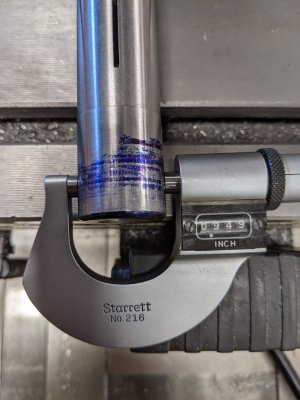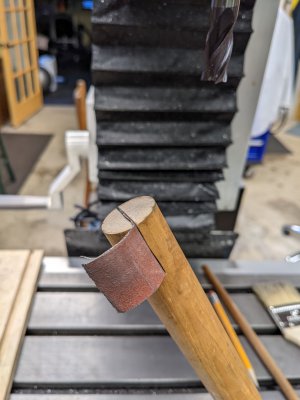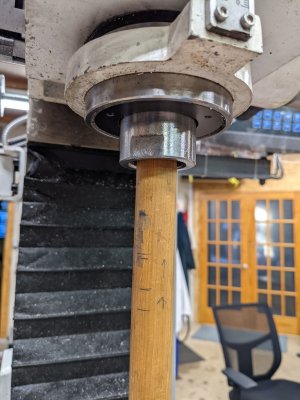- Joined
- Jan 20, 2016
- Messages
- 173
I am at least the 2nd owner on an Enco 8 x 28 knee mill. I came with 3 R8 collets that all went in and out easily.
One of the first things I bought was a set of R8 end mill holders. Imagine my surprise when none of them fit up inside the spindle! After a lot of investigation it appeared that the holders did meet the Bridgeport specs for the end diameter, and the spindle bore was .0005 too small. The PO had ground the end of his collets down to fit!
After a lot of head scratching, my father suggested taking a length of wood dowel, slotting it to hold a piece of Emory paper, putting the emory in the slot and wrapping a turn or two around the diameter. I turned the end of the dowel down to fit a cordless drill to drive it. I didn't have a great expectation for success, but with nothing to loose, I wrapped a piece of 220 grit around it a gave it a try.
I was amazed that after a few minutes of up and down in the bore my smallest end mill holder was starting to fit. I ran the drill a little faster, swapped in anew new emory, and a few minutes later they all fit just right.
I have no way to get up in there to measure the bore accurately, but the largest end mill holder is a nice slip fit. To be clear, I would not be concerned if the bore ended up .001 over. Nothing I will ever make ever make on this hobby machine would be affected.
One of the first things I bought was a set of R8 end mill holders. Imagine my surprise when none of them fit up inside the spindle! After a lot of investigation it appeared that the holders did meet the Bridgeport specs for the end diameter, and the spindle bore was .0005 too small. The PO had ground the end of his collets down to fit!
After a lot of head scratching, my father suggested taking a length of wood dowel, slotting it to hold a piece of Emory paper, putting the emory in the slot and wrapping a turn or two around the diameter. I turned the end of the dowel down to fit a cordless drill to drive it. I didn't have a great expectation for success, but with nothing to loose, I wrapped a piece of 220 grit around it a gave it a try.
I was amazed that after a few minutes of up and down in the bore my smallest end mill holder was starting to fit. I ran the drill a little faster, swapped in anew new emory, and a few minutes later they all fit just right.
I have no way to get up in there to measure the bore accurately, but the largest end mill holder is a nice slip fit. To be clear, I would not be concerned if the bore ended up .001 over. Nothing I will ever make ever make on this hobby machine would be affected.




